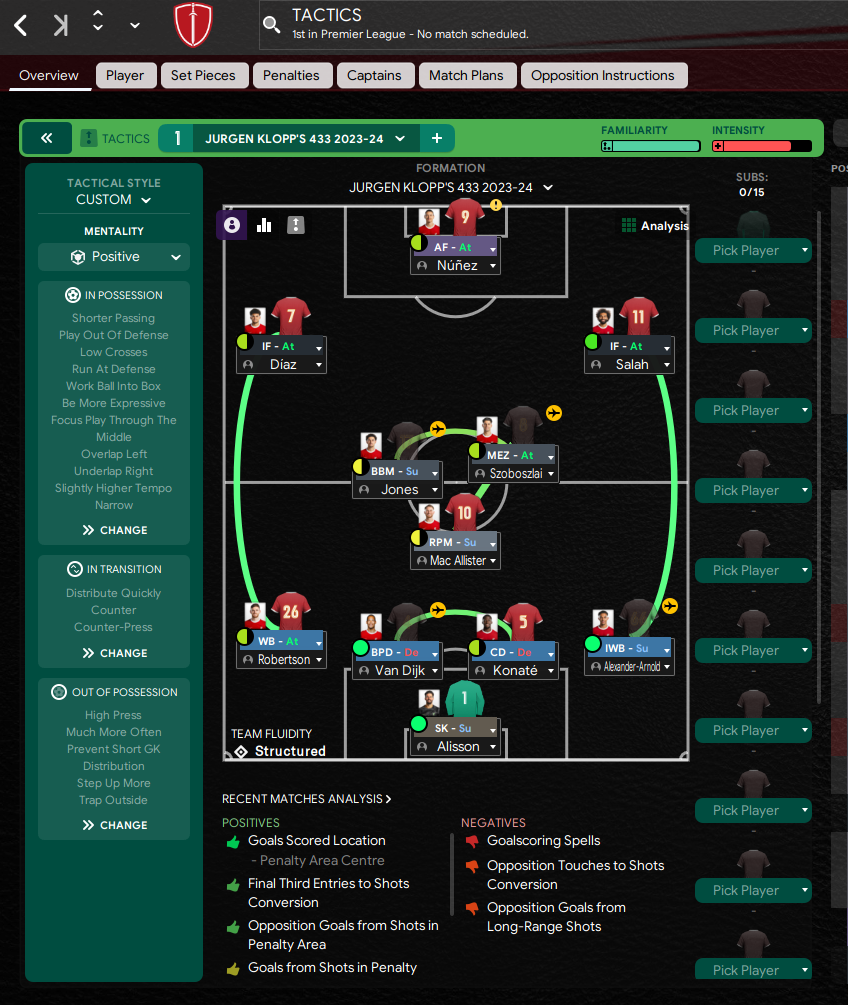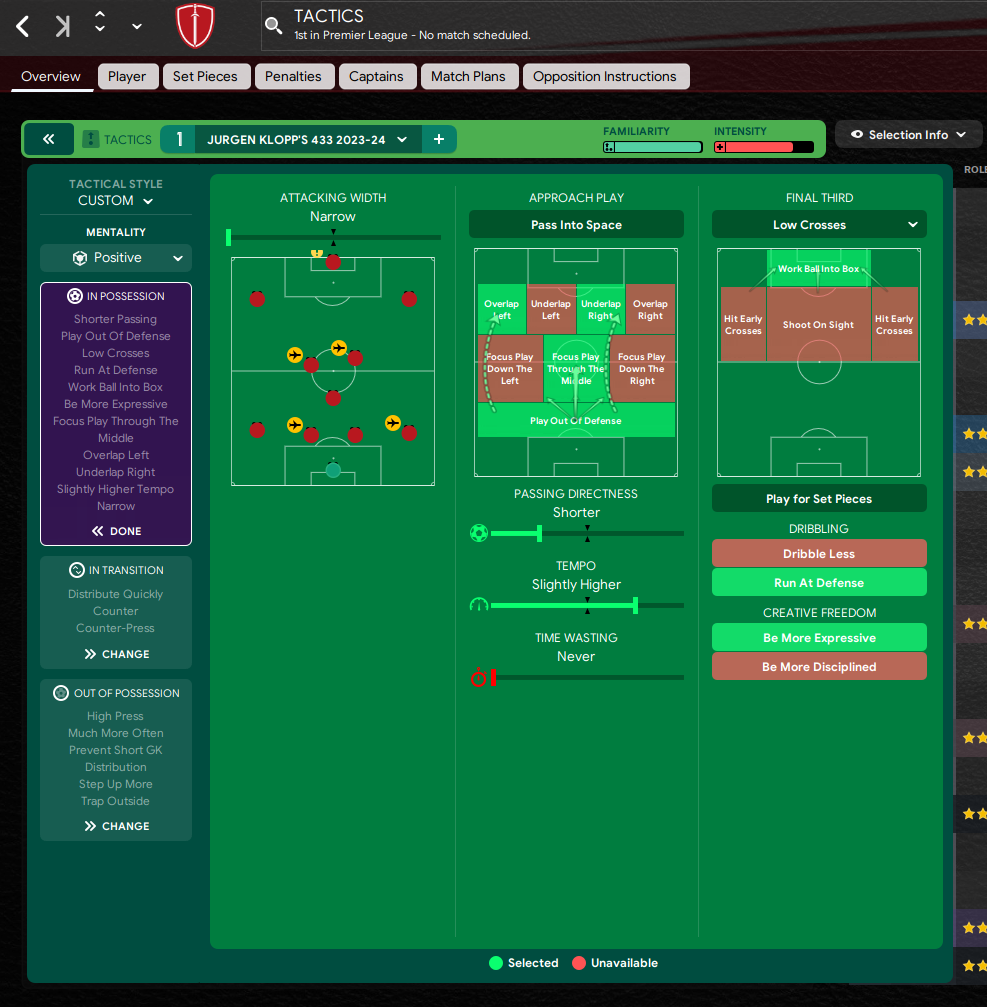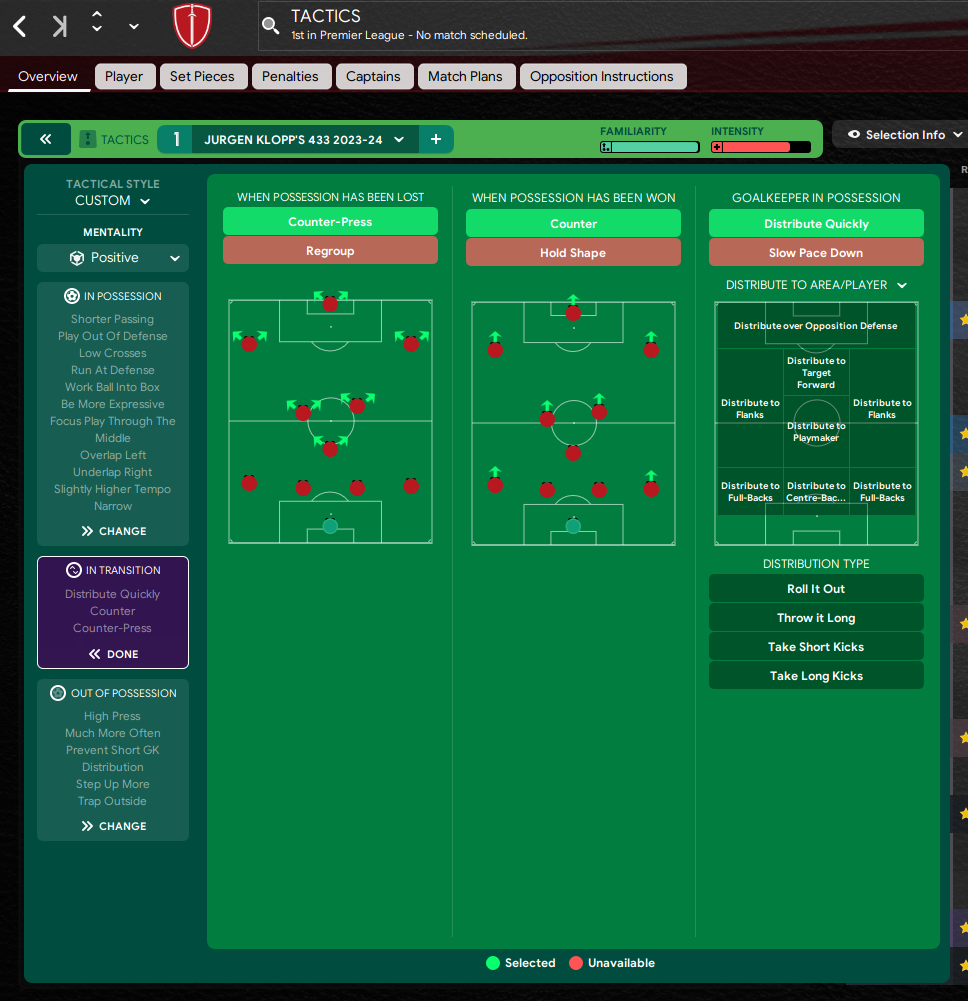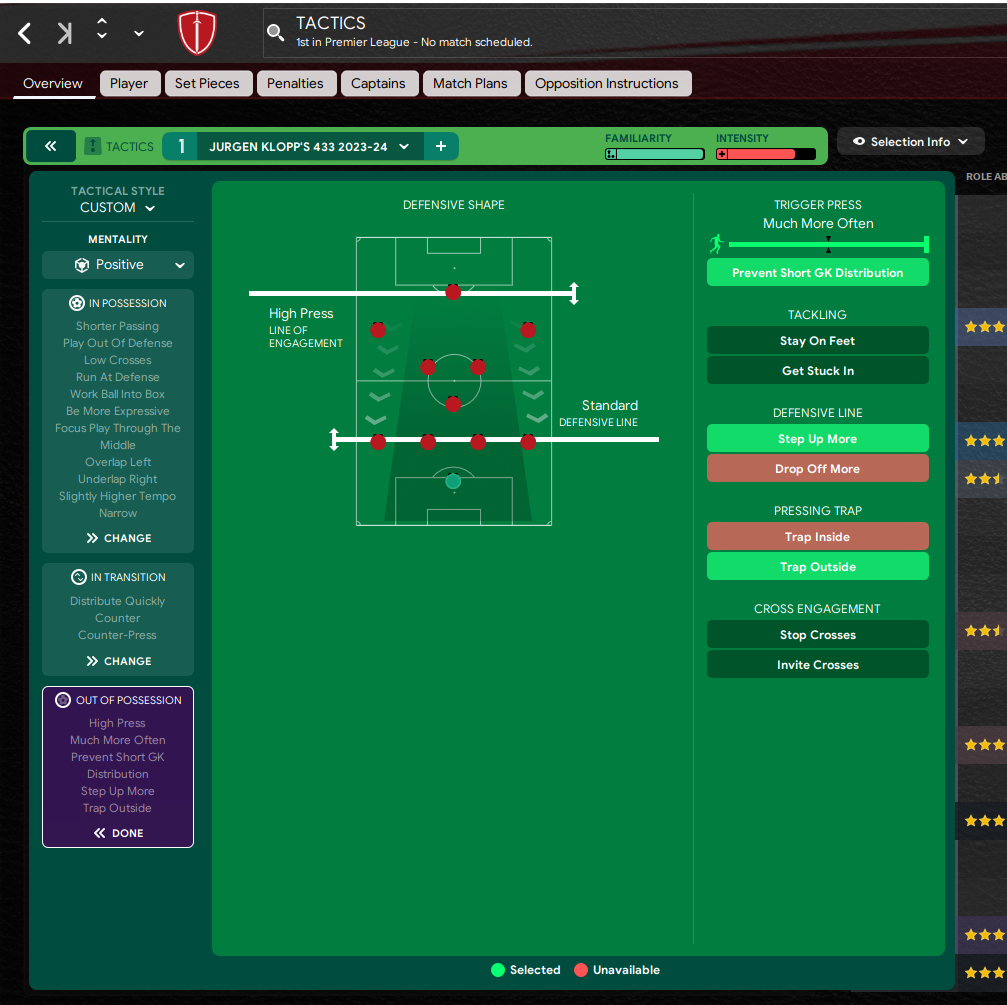| Tester | Team | ME | Win % | PPG | AGF | AGA | GD | PL | W | D | L | |
|---|---|---|---|---|---|---|---|---|---|---|---|---|
| Deleted User #1866315 |
 Liverpool
Liverpool
|
24.2.0 | 79% | 2.5 | 3.2 | 0.9 | 2.29 | 38 | 30 | 5 | 3 |
JURGEN KLOPP’S LIVERPOOL 4-3-3 SEASON 2023-2024
LIVERPOOL’S NEW MIDFIELD
Liverpool's midfield underwent a significant overhaul in the summer, transitioning from an aging core to a youthful, energetic unit known as 'Liverpool 2.0.' Departures of Fabinho, Henderson, Milner, Oxlade-Chamberlain, and Keita were met with the arrivals of Mac Allister, Szoboszlai, Gravenberch, and Endo.
In defensive midfield, Mac Allister's introduction brought improved possession and press resistance, showcasing a different skill set from his predecessors. Endo, a more traditional and aggressive option, added depth and defensive solidity to the squad.
Szoboszlai, a marquee signing, became a pivotal figure in the central midfield, providing dynamism, goal-scoring prowess, and creative contributions. His impact has been crucial in transforming Liverpool's midfield dynamics.
Gravenberch, a summer signing, demonstrated athleticism, on-ball prowess, and goal-scoring ability. Jones, along with Harvey Elliott, offered healthy competition and versatility on the left side, with Gravenberch adding a new dimension to the team's attacking capabilities.
Despite some defensive vulnerabilities in transition, Liverpool's revamped midfield has outperformed the previous season. Stefan Bajcetic and Thiago are yet to feature, suggesting further depth and potential improvements. Klopp's side is now in contention for their 20th title, reflecting the success of the strategic midfield overhaul.
TACTICAL ANALYSIS
Fabinho, Jordan Henderson, Naby Keïta, Alex Oxlade-Chamberlain, and James Milner have departed from the club, making way for new signings Dominik Szoboszlai, Alexis Mac Allister, Ryan Gravenberch, and Wataru Endo. The midfield of Liverpool is undergoing a significant overhaul. Despite the potential challenges posed by numerous changes, Liverpool has remarkably won five games and suffered only one defeat in eight league matches. Fortunately, the defensive and offensive lines have remained relatively stable, placing the spotlight on how quickly the new midfielders can assimilate into Liverpool's style. The relatively straightforward six games in the UEFA Europa League group stage offer an opportunity to provide valuable minutes for the newcomers.
In possession, Trent Alexander-Arnold transitioned to the midfield last season, playing a pivotal role in distributing the ball effectively. Szoboszlai, displaying remarkable adaptability, assumed a similar role during Alexander-Arnold's absence, showcasing precision in ball distribution. Notably, Darwin Núñez is in peak form, contributing not only with goals but also aiding in ball retention and initiating fast attacks when needed.
However, defensively, Liverpool faces challenges due to the absence of natural defensive midfielders. Mac Allister, originally positioned higher up the pitch, now plays as a pivot but struggles in winning duels to secure possession. Endo, a natural pivot, faces difficulties with the zonal pressing style, often following opponents too closely, requiring support from Alexander-Arnold or Szoboszlai during possession.
The sooner the new midfielders acclimate to the team, the greater the likelihood of a title challenge.
BUILD UP
In the context of building up play, adjustments have been made to Liverpool's shape this season. Initially, Alexander-Arnold occupied a central role, with Alisson forming part of the back four. However, around the third game against Newcastle, Alexander-Arnold shifted to the right flank, and Szoboszlai dropped alongside Mac Allister, creating a double pivot. This change, possibly a response to Newcastle's front three, persisted, with the right fullback consistently staying wide during build-up.
Liverpool remains comfortable playing long under pressure, often relying on an 8, primarily Szoboszlai or Curtis Jones, drifting wide. The wingers' ability to pin back the opposition provides ample space between the opposition fullback and winger, facilitating Liverpool's attacking transitions.
Despite Virgil van Dijk's tendency to play simplistically, Matip and Konaté offer a more dynamic option, carrying the ball forward to disrupt opponents and create passing opportunities. Núñez excels as a target during long plays, showcasing his ability to hold the ball and initiate fast attacks.
In midfield, Alexander-Arnold occasionally inverts, pushing Szoboszlai higher. Different starting positions for Szoboszlai, Jones, or Gakpo yield varied attacking routes. However, van Dijk's predictability in possession becomes a weakness, enabling opponents to anticipate passes and apply tighter pressure.
Liverpool's play through the middle depends on individual strengths, with Jota and Gakpo adept at receiving in tight spaces. The team's flexibility and triangular movements, highlighted in Pep Lijnders' book 'Intensity,' contribute to dynamic attacking options.
In the final third, Liverpool aims for quick penetration, utilizing counterattacks, quick transitions, or diagonal switches. Triangles play a crucial role, with wingers cutting inside, fullbacks providing passing lanes, and Szoboszlai supporting Salah on the right. The attacking approach adapts against deep defensive blocks, with emphasis on maintaining triangular structures.
Liverpool's high pressing remains a key strength, with adjustments this season. The pressing line drops slightly, maintaining a high defensive line for team compactness. Pressing triggers often come from the 8s, disrupting the opposition's passing lanes. However, the absence of a defensive midfielder like Fabinho poses challenges in regaining possession after pressing.
To address this, Liverpool focuses on maintaining compactness to secure second balls. However, the higher positioning of the 8s leaves Mac Allister covering vast spaces, affecting defensive stability. Against goal kicks, Salah steps up, altering the formation to a 4-4-2, facilitating higher pressure on opposition center-backs.
In the final third defensively, Liverpool aims to apply tight pressure to prevent crosses. The defensive midfielder shifts across, leaving the middle vulnerable, and cutbacks become effective. Winning the ball in wide areas is crucial, leading to potential counterattacks. While the pressing line drops, Liverpool remains collective, but resolving the defensive midfielder issue is essential to regain their former effectiveness.
In conclusion, Liverpool's tactical nuances encompass building up, pressing, and attacking intricacies. Adaptations reflect a collective approach, but addressing specific weaknesses, particularly in defensive midfield, remains crucial for sustained success. I hope you find this analysis insightful.
KLOPP’S 4-3-3 IN FOOTBALL MANAGER 2024
- Players roles and why I chose them
For this tactic, I started from a basic 4-3-3 with 1 midfielder as a shield in front of the defense and other two central midfielders.
Unexpectedly, Klopp decided to let the Argentinian Alexis Mc Allister play in Fabinho’s role, as a pivot in front of the defense. Compared to Fabinho, Mc Allister surely contributes more to possession and build-up but lacks in physical presence (he is not winning many defensive duels against the opponents and this creates a danger for LFC). Despite this, Klopp trusts him a lot and Mc Allister is rapidly adapting to his role. I tried the regista role for Mc Allister but in Football Manager as you may know, the regista is a more static role (even if he plays in support only). Mc Allister helps in possession and build up but also carries the ball, he and Szoboslai are the “free 8” mentioned above. So after testing him as a regista, I decided to switch his role to a roaming playmaker because this way I can see him moving with tbe ball and offering more options to his teammates.
The other two central midfielders are Szoboslai and Curtis Jones. Szoboslai helps both in possession and in carrying the ball to the opposite half and he is good at scoring too and in my season with Liverpool in Football Manager 2024 he played very well as a mezzala in attack. I chose this role after trying him as an advanced playmaker because as a mezzala he can give free rein to his attacking skills and push forward while as an AP he focused more in possession and playing the ball in the central area.
The other midfielder is Jones, his role is more defensive, I chose the box to box midfielder for him and instructed him to close down more and stay wider to cover wider spaces in the central area when Robertson pushes forward, he and the Scottish wing-back are often rotating and exchanging their position. You maybe would like to use him as a central midfielder and instruct him to stay wider and then choose his duty (since you have a mezzala in attack and a roaming playmaker in support, you maybe want a defensive midfielder too to create a balanced midfielder), because in the game the CM gives you more instructions options while a BBM has some preset instructions that you can’t change. Anyway, I chose the BBM role because I wanted to emulate those rotations on the left side, in other words, as a BBM Jones can also push forward and help in attack when Robertson is in a more defensive position, while if I play him as a central midfielder in defense, Jones will always stay back.
Having that said, in the video you will see that I click on 2 options in some roles (also the forward role with Jota or Nunez), because I want to show what I am writing about now in this description. In the download tactic of course you will find only one choice, but you can change the role as I explained here also taking into consideration your players features if you are not using this tactic in a season with Liverpool as I did.
For the other roles, Alissson is a sweeper keeper in support who can both pass to the defenders to build from the back and also kick the ball long to find the forwards when the opponent players are not well positioned.
Trent Alexander-Arnold is of course an inverted wing-back on support, in last season 2022-23 we often saw him playing as a central midfielder and he did quite well helping to build the play and in possession, this season he plays as an inverted-wing back who moves to the central areas to help as a central midfielder in possession.
The two central defenders are Konate and Virgil, Konate is more defensive so I chose for him a simple central defender role and instructed him to mark tighter and close down less (this to avoid him getting caught too high when he presses the opponent). For Virgil, he is perfect as a ball - playing defender in defend, in his case I instruct him to mark tighter, close down more because I want him to press high and also to dribble more because this way you will see him carrying the ball to the opponent’s half. Lastly, on the left side, Robertson is a wing-back in attack and I instructed him to close down more and mark tighter too. He will push forwards whenever he can and help the team in possession and in attack. I did not instruct him to stay wider or narrower because I prefer to let him decide according to the team instructions.
As for the attack trio, for Salah on the right and Diaz on the left, I chose the inside forward in attack because I want them to unleash all their attacking potential. Only for Salah, I instructed him to shoot more often and stay wider because I want more goals from him and also to cover wide spaces since Arnold plays more inside.
The last player role was the most difficult choice for me maybe, Darwin Nunez’s role. He can be seen as a pressing forward (in attack or support, it’s your choice) because he helps press the opponent central defenders to gain the ball very high in the pitch. But after I tested him in that position for a few games I saw he did not score a lot even if he was helping in the pressing phase, then I switched to an advanced forward and from the results I got (top scorer in Premier League and a lot of goals also in the other competitions) I understood I made the right choice.
- Team instructions
Mentality: I start with a positive mentality (or you can even start with a balanced one with stronger opponents to see how it works and change it to a positive during the game, but if you are losing, you can switch to an attacking one combining it with a higher defense and a much higher tempo)
In possession
Attacking width: narrow or fairly narrow. Liverpool focus the play in the central area rather than on the flanks despite having 2 wing-backs like Robertson and Alexander Arnold who can play very wide.
Play out of defense: with a sweeper-keeper like Alisson who is very good in playing with the ball and a central defender like Virgi, build from the back is surely one of the most used options in Liverpool play.
Focus play in the middle: as I said before, this year Liverpool prefers to focus the play in the middle with Alexander Arnold being an inverted wing-back who acts like a central midfielder in possession (and he played as central midfielder last season too).
Overlap left: for Robertson, he obviously is not an inverted wing-back, he will overlap on the left flank every time he has the chance.
Underlap right: on the right side, Alexander Arnold plays more in the center and can also run forward to the opponent’s box, always starting the run from a central position.
Pass into space or not: I didn’t choose to pass into space to maintain more possession, but actually you can also select this option if you want a more vertical game.
Low crosses, run at defense (this instruction is perfect for Salah, Diaz and Nunez), be more expressive.
In transition
Counter-press: well, no need to explain why here, it’s Klopp, it’s gegenpressing, yeah!
Counter: after gaining the ball very high, counter is a very easy task, sometimes my forward wins the ball back just in front of the opponent’s box and then scores.
For Alisson, no instructions except distribute quickly because I let him decide to play long or short balls according to the situation. With long balls he can catch the opponent off-guard.
Out of possession
High pressing line: we want to win the ball back in the opponent’s half
Standard defensive line: I chose this option to avoid being caught off-guard by the opponent’s long balls due to the fact we have three forwards with attack duty (IF+IF+AF) and a midfield trio not so good in defense. But you can switch to a higher or even much higher defensive line in case you are losing or struggling to score. And you can adjust it according also to the type of team you are managing and the opponent’s strength.
Prevent short gk distribution
Pressing: much more often, we want our team to press the opponent forcing them to make mistakes.
Step up more to apply off-side trap
Trap outside to force the opponent to play on the flanks giving them less options to pass or dribble.
This is all for this tactic. I won all the trophies (Premier League, Europa League, FA CUP and Carabao Cup), lost only 3 times.
I lost the last Premier League game against Tottenham. I was very lucky because Manchester City did not win, if they won we would have finished with the same points, 95. Anyway I would have won the title because my score against Manchester City was 1-2 away and 3-1 home but it’s not beautiful to win like that, what do you think?
Test Results
 Liverpool
Liverpool
You'll need to Login to comment




